Ethical Issues of Smartphone Use in Clinical Settings: A Report
VerifiedAdded on 2023/01/19
|6
|1692
|84
Report
AI Summary
This report delves into the ethical challenges posed by smartphone use in clinical settings, particularly focusing on the nursing profession. It begins by introducing the increasing prevalence of smartphones in healthcare and the subsequent ethical concerns. The report identifies and analyzes two key ethical issues: patient confidentiality and distractions from clinical tasks. The analysis explores how the use of smartphones can compromise patient privacy through unsecured messaging, accidental data leaks, and the sharing of sensitive information. Furthermore, it examines how smartphone use can distract nurses, potentially leading to errors and reduced patient safety. The report evaluates these issues, highlighting the need for policy guidelines and education to mitigate risks. It concludes by recommending the use of smartphones in specific contexts but emphasizes the importance of regulations to protect patient privacy and ensure quality healthcare delivery. The report supports its arguments with references to relevant research and studies.
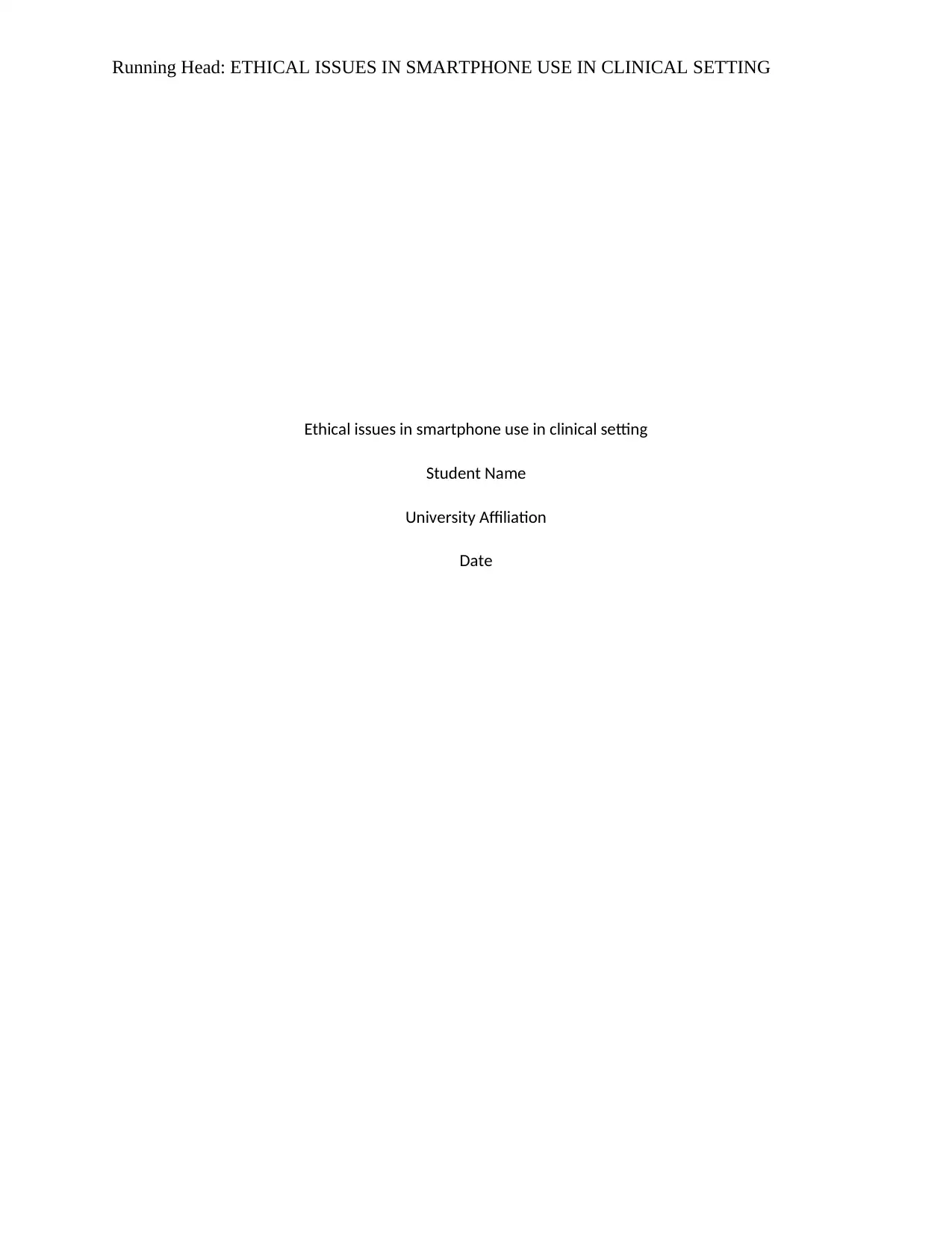
Running Head: ETHICAL ISSUES IN SMARTPHONE USE IN CLINICAL SETTING
Ethical issues in smartphone use in clinical setting
Student Name
University Affiliation
Date
Ethical issues in smartphone use in clinical setting
Student Name
University Affiliation
Date
Paraphrase This Document
Need a fresh take? Get an instant paraphrase of this document with our AI Paraphraser
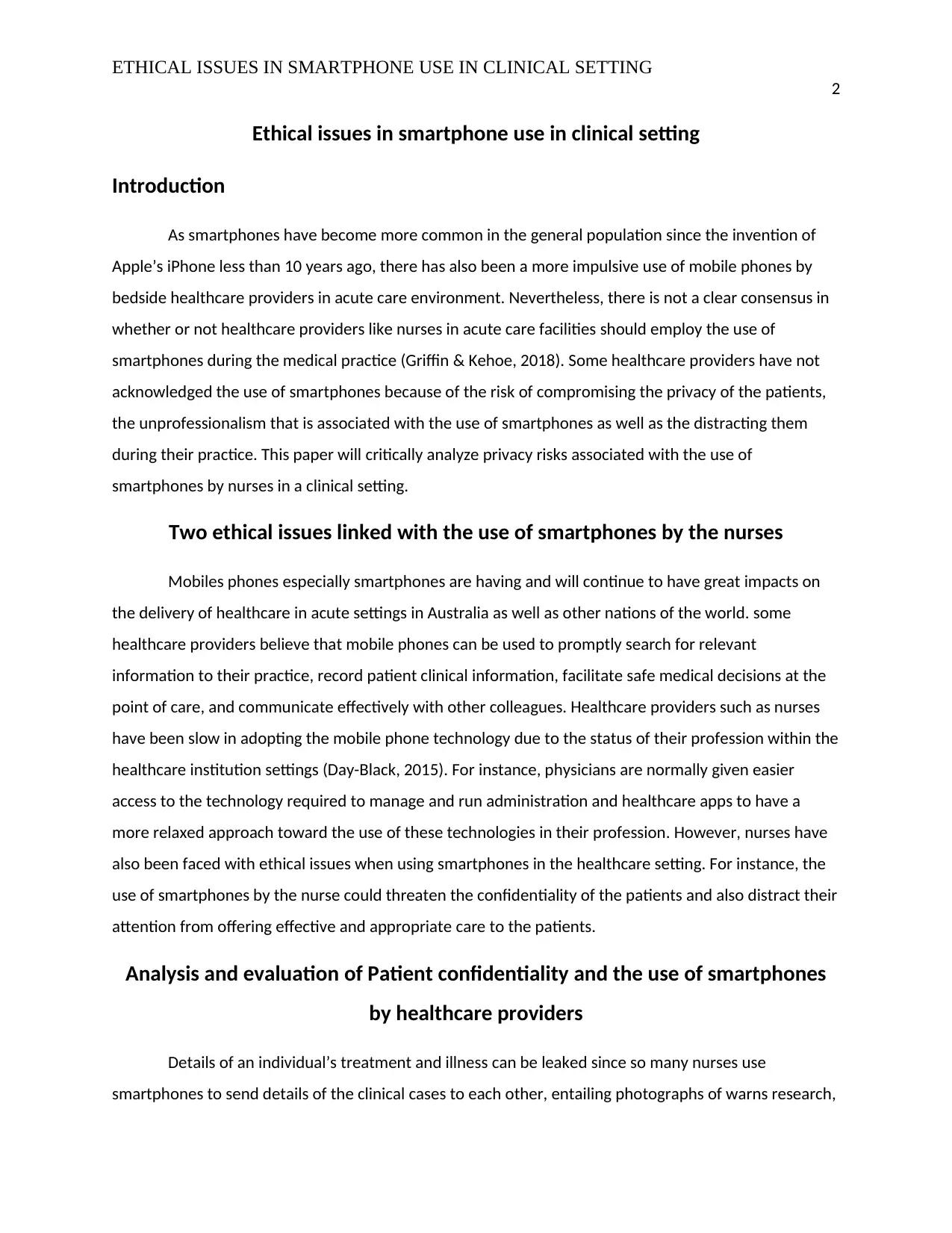
ETHICAL ISSUES IN SMARTPHONE USE IN CLINICAL SETTING
2
Ethical issues in smartphone use in clinical setting
Introduction
As smartphones have become more common in the general population since the invention of
Apple’s iPhone less than 10 years ago, there has also been a more impulsive use of mobile phones by
bedside healthcare providers in acute care environment. Nevertheless, there is not a clear consensus in
whether or not healthcare providers like nurses in acute care facilities should employ the use of
smartphones during the medical practice (Griffin & Kehoe, 2018). Some healthcare providers have not
acknowledged the use of smartphones because of the risk of compromising the privacy of the patients,
the unprofessionalism that is associated with the use of smartphones as well as the distracting them
during their practice. This paper will critically analyze privacy risks associated with the use of
smartphones by nurses in a clinical setting.
Two ethical issues linked with the use of smartphones by the nurses
Mobiles phones especially smartphones are having and will continue to have great impacts on
the delivery of healthcare in acute settings in Australia as well as other nations of the world. some
healthcare providers believe that mobile phones can be used to promptly search for relevant
information to their practice, record patient clinical information, facilitate safe medical decisions at the
point of care, and communicate effectively with other colleagues. Healthcare providers such as nurses
have been slow in adopting the mobile phone technology due to the status of their profession within the
healthcare institution settings (Day-Black, 2015). For instance, physicians are normally given easier
access to the technology required to manage and run administration and healthcare apps to have a
more relaxed approach toward the use of these technologies in their profession. However, nurses have
also been faced with ethical issues when using smartphones in the healthcare setting. For instance, the
use of smartphones by the nurse could threaten the confidentiality of the patients and also distract their
attention from offering effective and appropriate care to the patients.
Analysis and evaluation of Patient confidentiality and the use of smartphones
by healthcare providers
Details of an individual’s treatment and illness can be leaked since so many nurses use
smartphones to send details of the clinical cases to each other, entailing photographs of warns research,
2
Ethical issues in smartphone use in clinical setting
Introduction
As smartphones have become more common in the general population since the invention of
Apple’s iPhone less than 10 years ago, there has also been a more impulsive use of mobile phones by
bedside healthcare providers in acute care environment. Nevertheless, there is not a clear consensus in
whether or not healthcare providers like nurses in acute care facilities should employ the use of
smartphones during the medical practice (Griffin & Kehoe, 2018). Some healthcare providers have not
acknowledged the use of smartphones because of the risk of compromising the privacy of the patients,
the unprofessionalism that is associated with the use of smartphones as well as the distracting them
during their practice. This paper will critically analyze privacy risks associated with the use of
smartphones by nurses in a clinical setting.
Two ethical issues linked with the use of smartphones by the nurses
Mobiles phones especially smartphones are having and will continue to have great impacts on
the delivery of healthcare in acute settings in Australia as well as other nations of the world. some
healthcare providers believe that mobile phones can be used to promptly search for relevant
information to their practice, record patient clinical information, facilitate safe medical decisions at the
point of care, and communicate effectively with other colleagues. Healthcare providers such as nurses
have been slow in adopting the mobile phone technology due to the status of their profession within the
healthcare institution settings (Day-Black, 2015). For instance, physicians are normally given easier
access to the technology required to manage and run administration and healthcare apps to have a
more relaxed approach toward the use of these technologies in their profession. However, nurses have
also been faced with ethical issues when using smartphones in the healthcare setting. For instance, the
use of smartphones by the nurse could threaten the confidentiality of the patients and also distract their
attention from offering effective and appropriate care to the patients.
Analysis and evaluation of Patient confidentiality and the use of smartphones
by healthcare providers
Details of an individual’s treatment and illness can be leaked since so many nurses use
smartphones to send details of the clinical cases to each other, entailing photographs of warns research,
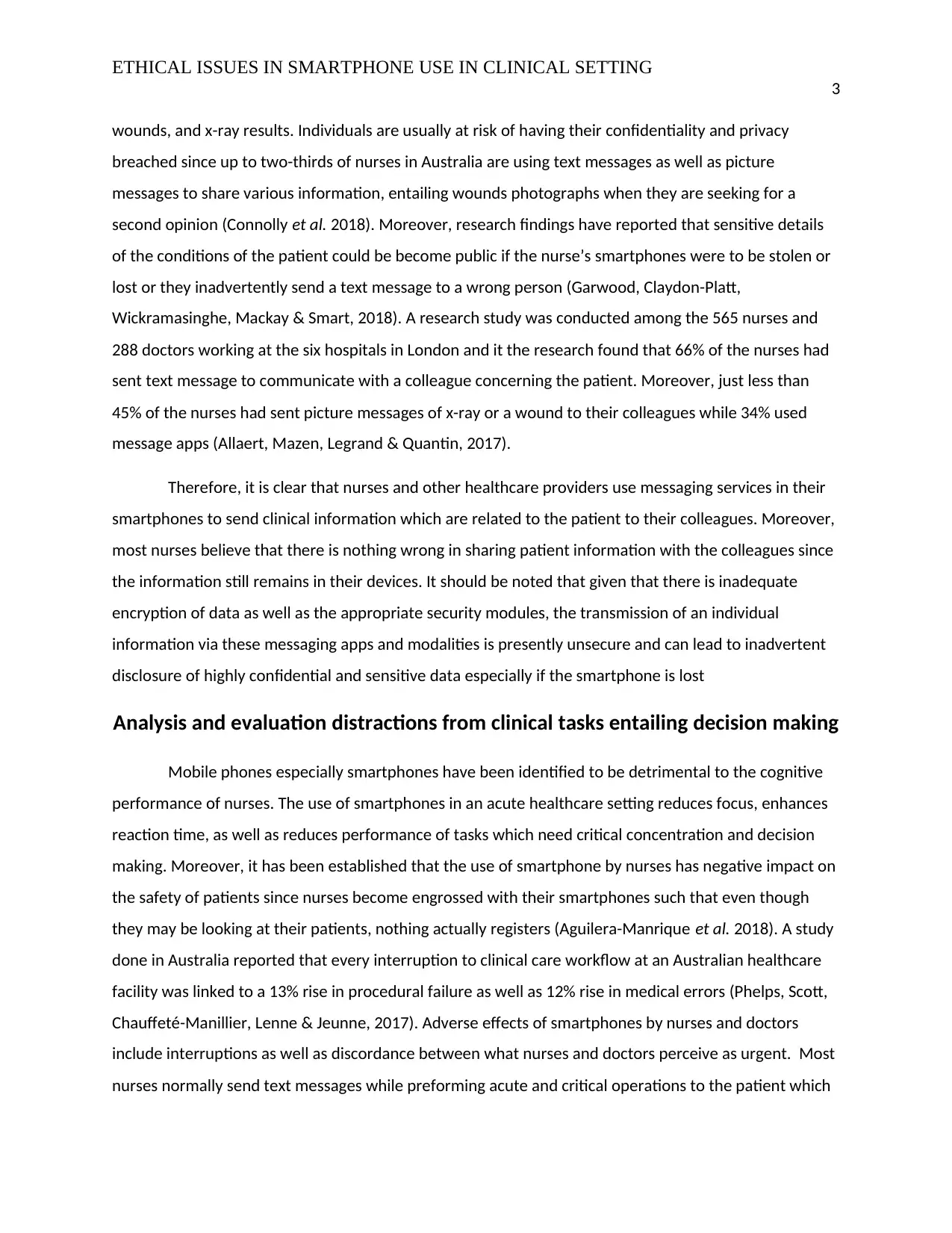
ETHICAL ISSUES IN SMARTPHONE USE IN CLINICAL SETTING
3
wounds, and x-ray results. Individuals are usually at risk of having their confidentiality and privacy
breached since up to two-thirds of nurses in Australia are using text messages as well as picture
messages to share various information, entailing wounds photographs when they are seeking for a
second opinion (Connolly et al. 2018). Moreover, research findings have reported that sensitive details
of the conditions of the patient could be become public if the nurse’s smartphones were to be stolen or
lost or they inadvertently send a text message to a wrong person (Garwood, Claydon-Platt,
Wickramasinghe, Mackay & Smart, 2018). A research study was conducted among the 565 nurses and
288 doctors working at the six hospitals in London and it the research found that 66% of the nurses had
sent text message to communicate with a colleague concerning the patient. Moreover, just less than
45% of the nurses had sent picture messages of x-ray or a wound to their colleagues while 34% used
message apps (Allaert, Mazen, Legrand & Quantin, 2017).
Therefore, it is clear that nurses and other healthcare providers use messaging services in their
smartphones to send clinical information which are related to the patient to their colleagues. Moreover,
most nurses believe that there is nothing wrong in sharing patient information with the colleagues since
the information still remains in their devices. It should be noted that given that there is inadequate
encryption of data as well as the appropriate security modules, the transmission of an individual
information via these messaging apps and modalities is presently unsecure and can lead to inadvertent
disclosure of highly confidential and sensitive data especially if the smartphone is lost
Analysis and evaluation distractions from clinical tasks entailing decision making
Mobile phones especially smartphones have been identified to be detrimental to the cognitive
performance of nurses. The use of smartphones in an acute healthcare setting reduces focus, enhances
reaction time, as well as reduces performance of tasks which need critical concentration and decision
making. Moreover, it has been established that the use of smartphone by nurses has negative impact on
the safety of patients since nurses become engrossed with their smartphones such that even though
they may be looking at their patients, nothing actually registers (Aguilera-Manrique et al. 2018). A study
done in Australia reported that every interruption to clinical care workflow at an Australian healthcare
facility was linked to a 13% rise in procedural failure as well as 12% rise in medical errors (Phelps, Scott,
Chauffeté-Manillier, Lenne & Jeunne, 2017). Adverse effects of smartphones by nurses and doctors
include interruptions as well as discordance between what nurses and doctors perceive as urgent. Most
nurses normally send text messages while preforming acute and critical operations to the patient which
3
wounds, and x-ray results. Individuals are usually at risk of having their confidentiality and privacy
breached since up to two-thirds of nurses in Australia are using text messages as well as picture
messages to share various information, entailing wounds photographs when they are seeking for a
second opinion (Connolly et al. 2018). Moreover, research findings have reported that sensitive details
of the conditions of the patient could be become public if the nurse’s smartphones were to be stolen or
lost or they inadvertently send a text message to a wrong person (Garwood, Claydon-Platt,
Wickramasinghe, Mackay & Smart, 2018). A research study was conducted among the 565 nurses and
288 doctors working at the six hospitals in London and it the research found that 66% of the nurses had
sent text message to communicate with a colleague concerning the patient. Moreover, just less than
45% of the nurses had sent picture messages of x-ray or a wound to their colleagues while 34% used
message apps (Allaert, Mazen, Legrand & Quantin, 2017).
Therefore, it is clear that nurses and other healthcare providers use messaging services in their
smartphones to send clinical information which are related to the patient to their colleagues. Moreover,
most nurses believe that there is nothing wrong in sharing patient information with the colleagues since
the information still remains in their devices. It should be noted that given that there is inadequate
encryption of data as well as the appropriate security modules, the transmission of an individual
information via these messaging apps and modalities is presently unsecure and can lead to inadvertent
disclosure of highly confidential and sensitive data especially if the smartphone is lost
Analysis and evaluation distractions from clinical tasks entailing decision making
Mobile phones especially smartphones have been identified to be detrimental to the cognitive
performance of nurses. The use of smartphones in an acute healthcare setting reduces focus, enhances
reaction time, as well as reduces performance of tasks which need critical concentration and decision
making. Moreover, it has been established that the use of smartphone by nurses has negative impact on
the safety of patients since nurses become engrossed with their smartphones such that even though
they may be looking at their patients, nothing actually registers (Aguilera-Manrique et al. 2018). A study
done in Australia reported that every interruption to clinical care workflow at an Australian healthcare
facility was linked to a 13% rise in procedural failure as well as 12% rise in medical errors (Phelps, Scott,
Chauffeté-Manillier, Lenne & Jeunne, 2017). Adverse effects of smartphones by nurses and doctors
include interruptions as well as discordance between what nurses and doctors perceive as urgent. Most
nurses normally send text messages while preforming acute and critical operations to the patient which
⊘ This is a preview!⊘
Do you want full access?
Subscribe today to unlock all pages.

Trusted by 1+ million students worldwide
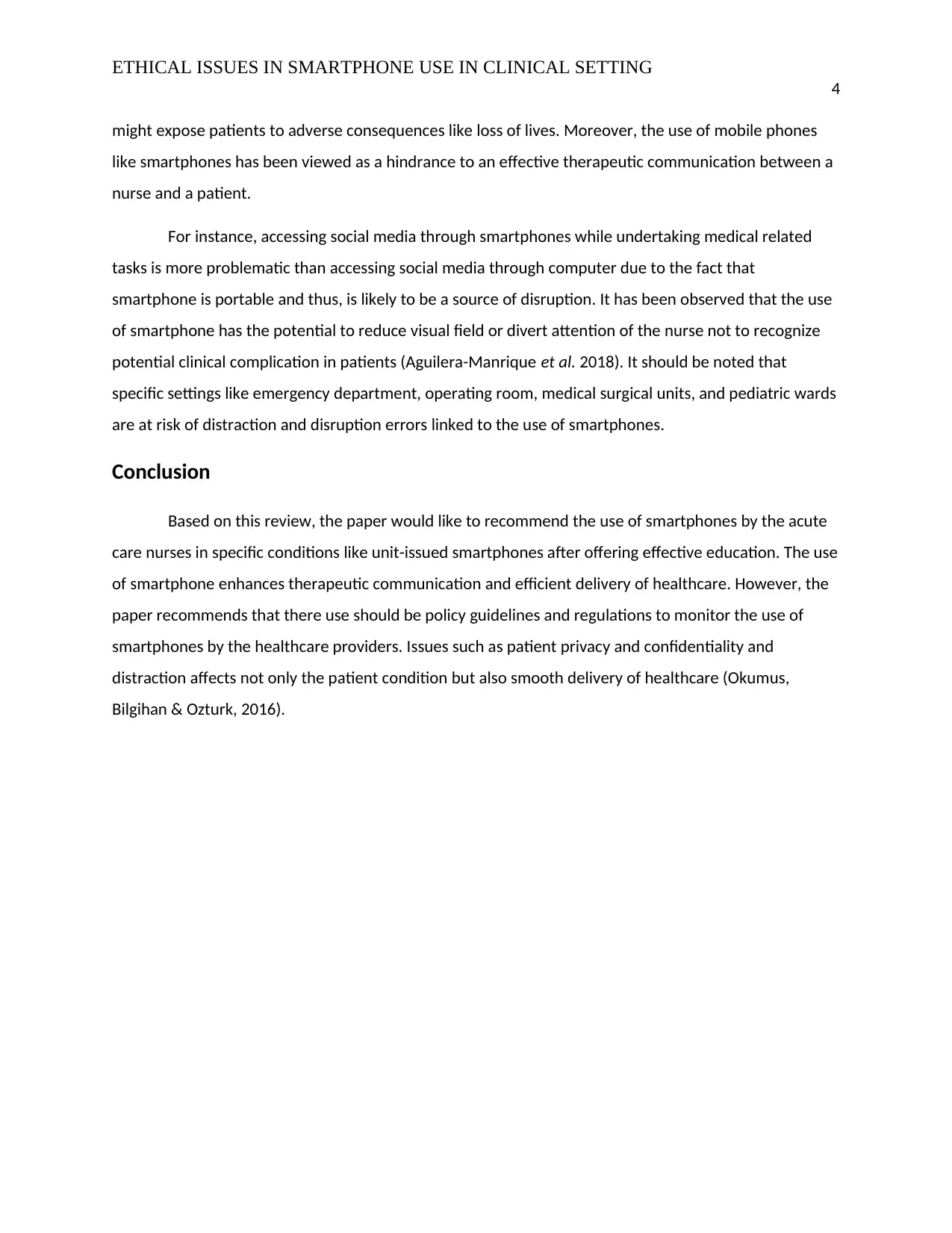
ETHICAL ISSUES IN SMARTPHONE USE IN CLINICAL SETTING
4
might expose patients to adverse consequences like loss of lives. Moreover, the use of mobile phones
like smartphones has been viewed as a hindrance to an effective therapeutic communication between a
nurse and a patient.
For instance, accessing social media through smartphones while undertaking medical related
tasks is more problematic than accessing social media through computer due to the fact that
smartphone is portable and thus, is likely to be a source of disruption. It has been observed that the use
of smartphone has the potential to reduce visual field or divert attention of the nurse not to recognize
potential clinical complication in patients (Aguilera-Manrique et al. 2018). It should be noted that
specific settings like emergency department, operating room, medical surgical units, and pediatric wards
are at risk of distraction and disruption errors linked to the use of smartphones.
Conclusion
Based on this review, the paper would like to recommend the use of smartphones by the acute
care nurses in specific conditions like unit-issued smartphones after offering effective education. The use
of smartphone enhances therapeutic communication and efficient delivery of healthcare. However, the
paper recommends that there use should be policy guidelines and regulations to monitor the use of
smartphones by the healthcare providers. Issues such as patient privacy and confidentiality and
distraction affects not only the patient condition but also smooth delivery of healthcare (Okumus,
Bilgihan & Ozturk, 2016).
4
might expose patients to adverse consequences like loss of lives. Moreover, the use of mobile phones
like smartphones has been viewed as a hindrance to an effective therapeutic communication between a
nurse and a patient.
For instance, accessing social media through smartphones while undertaking medical related
tasks is more problematic than accessing social media through computer due to the fact that
smartphone is portable and thus, is likely to be a source of disruption. It has been observed that the use
of smartphone has the potential to reduce visual field or divert attention of the nurse not to recognize
potential clinical complication in patients (Aguilera-Manrique et al. 2018). It should be noted that
specific settings like emergency department, operating room, medical surgical units, and pediatric wards
are at risk of distraction and disruption errors linked to the use of smartphones.
Conclusion
Based on this review, the paper would like to recommend the use of smartphones by the acute
care nurses in specific conditions like unit-issued smartphones after offering effective education. The use
of smartphone enhances therapeutic communication and efficient delivery of healthcare. However, the
paper recommends that there use should be policy guidelines and regulations to monitor the use of
smartphones by the healthcare providers. Issues such as patient privacy and confidentiality and
distraction affects not only the patient condition but also smooth delivery of healthcare (Okumus,
Bilgihan & Ozturk, 2016).
Paraphrase This Document
Need a fresh take? Get an instant paraphrase of this document with our AI Paraphraser
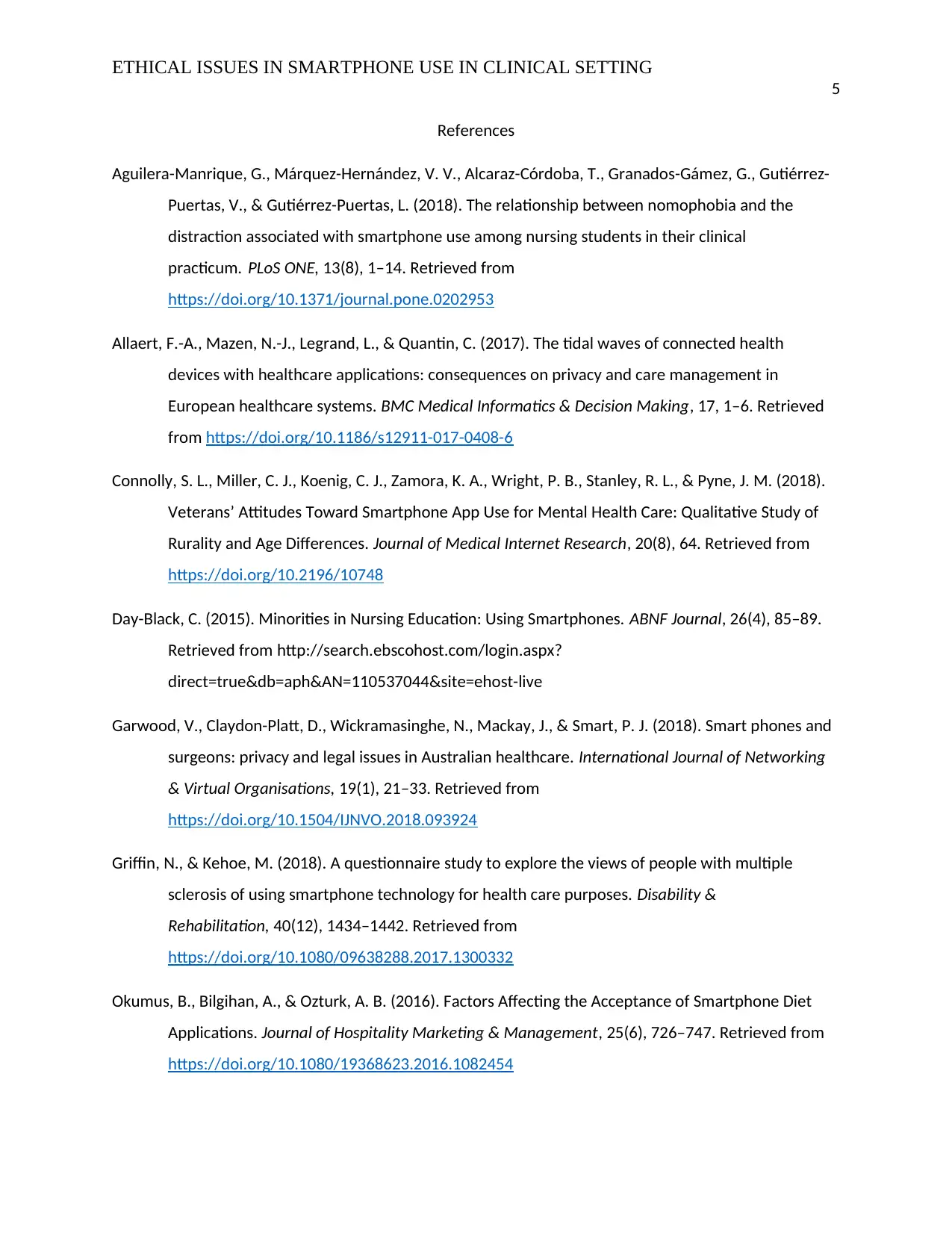
ETHICAL ISSUES IN SMARTPHONE USE IN CLINICAL SETTING
5
References
Aguilera-Manrique, G., Márquez-Hernández, V. V., Alcaraz-Córdoba, T., Granados-Gámez, G., Gutiérrez-
Puertas, V., & Gutiérrez-Puertas, L. (2018). The relationship between nomophobia and the
distraction associated with smartphone use among nursing students in their clinical
practicum. PLoS ONE, 13(8), 1–14. Retrieved from
https://doi.org/10.1371/journal.pone.0202953
Allaert, F.-A., Mazen, N.-J., Legrand, L., & Quantin, C. (2017). The tidal waves of connected health
devices with healthcare applications: consequences on privacy and care management in
European healthcare systems. BMC Medical Informatics & Decision Making, 17, 1–6. Retrieved
from https://doi.org/10.1186/s12911-017-0408-6
Connolly, S. L., Miller, C. J., Koenig, C. J., Zamora, K. A., Wright, P. B., Stanley, R. L., & Pyne, J. M. (2018).
Veterans’ Attitudes Toward Smartphone App Use for Mental Health Care: Qualitative Study of
Rurality and Age Differences. Journal of Medical Internet Research, 20(8), 64. Retrieved from
https://doi.org/10.2196/10748
Day-Black, C. (2015). Minorities in Nursing Education: Using Smartphones. ABNF Journal, 26(4), 85–89.
Retrieved from http://search.ebscohost.com/login.aspx?
direct=true&db=aph&AN=110537044&site=ehost-live
Garwood, V., Claydon-Platt, D., Wickramasinghe, N., Mackay, J., & Smart, P. J. (2018). Smart phones and
surgeons: privacy and legal issues in Australian healthcare. International Journal of Networking
& Virtual Organisations, 19(1), 21–33. Retrieved from
https://doi.org/10.1504/IJNVO.2018.093924
Griffin, N., & Kehoe, M. (2018). A questionnaire study to explore the views of people with multiple
sclerosis of using smartphone technology for health care purposes. Disability &
Rehabilitation, 40(12), 1434–1442. Retrieved from
https://doi.org/10.1080/09638288.2017.1300332
Okumus, B., Bilgihan, A., & Ozturk, A. B. (2016). Factors Affecting the Acceptance of Smartphone Diet
Applications. Journal of Hospitality Marketing & Management, 25(6), 726–747. Retrieved from
https://doi.org/10.1080/19368623.2016.1082454
5
References
Aguilera-Manrique, G., Márquez-Hernández, V. V., Alcaraz-Córdoba, T., Granados-Gámez, G., Gutiérrez-
Puertas, V., & Gutiérrez-Puertas, L. (2018). The relationship between nomophobia and the
distraction associated with smartphone use among nursing students in their clinical
practicum. PLoS ONE, 13(8), 1–14. Retrieved from
https://doi.org/10.1371/journal.pone.0202953
Allaert, F.-A., Mazen, N.-J., Legrand, L., & Quantin, C. (2017). The tidal waves of connected health
devices with healthcare applications: consequences on privacy and care management in
European healthcare systems. BMC Medical Informatics & Decision Making, 17, 1–6. Retrieved
from https://doi.org/10.1186/s12911-017-0408-6
Connolly, S. L., Miller, C. J., Koenig, C. J., Zamora, K. A., Wright, P. B., Stanley, R. L., & Pyne, J. M. (2018).
Veterans’ Attitudes Toward Smartphone App Use for Mental Health Care: Qualitative Study of
Rurality and Age Differences. Journal of Medical Internet Research, 20(8), 64. Retrieved from
https://doi.org/10.2196/10748
Day-Black, C. (2015). Minorities in Nursing Education: Using Smartphones. ABNF Journal, 26(4), 85–89.
Retrieved from http://search.ebscohost.com/login.aspx?
direct=true&db=aph&AN=110537044&site=ehost-live
Garwood, V., Claydon-Platt, D., Wickramasinghe, N., Mackay, J., & Smart, P. J. (2018). Smart phones and
surgeons: privacy and legal issues in Australian healthcare. International Journal of Networking
& Virtual Organisations, 19(1), 21–33. Retrieved from
https://doi.org/10.1504/IJNVO.2018.093924
Griffin, N., & Kehoe, M. (2018). A questionnaire study to explore the views of people with multiple
sclerosis of using smartphone technology for health care purposes. Disability &
Rehabilitation, 40(12), 1434–1442. Retrieved from
https://doi.org/10.1080/09638288.2017.1300332
Okumus, B., Bilgihan, A., & Ozturk, A. B. (2016). Factors Affecting the Acceptance of Smartphone Diet
Applications. Journal of Hospitality Marketing & Management, 25(6), 726–747. Retrieved from
https://doi.org/10.1080/19368623.2016.1082454
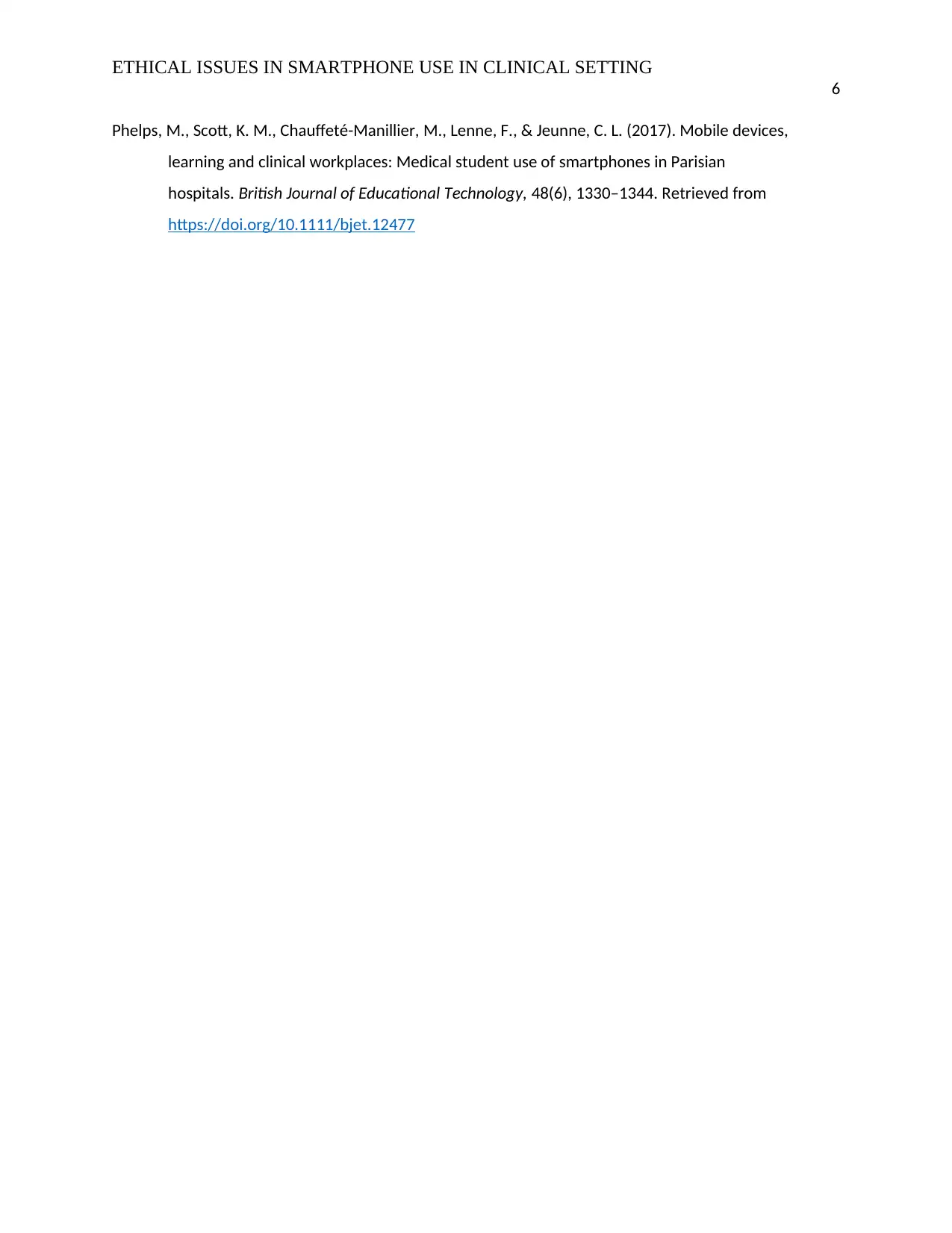
ETHICAL ISSUES IN SMARTPHONE USE IN CLINICAL SETTING
6
Phelps, M., Scott, K. M., Chauffeté-Manillier, M., Lenne, F., & Jeunne, C. L. (2017). Mobile devices,
learning and clinical workplaces: Medical student use of smartphones in Parisian
hospitals. British Journal of Educational Technology, 48(6), 1330–1344. Retrieved from
https://doi.org/10.1111/bjet.12477
6
Phelps, M., Scott, K. M., Chauffeté-Manillier, M., Lenne, F., & Jeunne, C. L. (2017). Mobile devices,
learning and clinical workplaces: Medical student use of smartphones in Parisian
hospitals. British Journal of Educational Technology, 48(6), 1330–1344. Retrieved from
https://doi.org/10.1111/bjet.12477
⊘ This is a preview!⊘
Do you want full access?
Subscribe today to unlock all pages.

Trusted by 1+ million students worldwide
1 out of 6
Related Documents
Your All-in-One AI-Powered Toolkit for Academic Success.
+13062052269
info@desklib.com
Available 24*7 on WhatsApp / Email
![[object Object]](/_next/static/media/star-bottom.7253800d.svg)
Unlock your academic potential
Copyright © 2020–2025 A2Z Services. All Rights Reserved. Developed and managed by ZUCOL.




